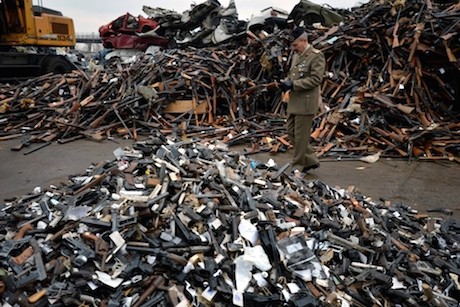Project: Targeting weapons - misuse of weapons in Serbia30Mar2015
Regional cooperation key to security in South East Europe
 Regional cooperation on combating the illicit proliferation of small arms and light weapons is the way forward, UNDP and EU officials agreed during a roundtable in Brussels, convened by UNDP's SEESAC initiative.
Regional cooperation on combating the illicit proliferation of small arms and light weapons is the way forward, UNDP and EU officials agreed during a roundtable in Brussels, convened by UNDP's SEESAC initiative.
The event brought together speakers from the European Commission, European External Action Service, Europol and the government of Croatia to discuss current efforts in tackling the threat posed by illicit proliferation of light weapons.
“During 2007 – 2012, we have managed to collect from our citizens over 2,515,000 kilos of explosives, 8000 pieces of weapons, 1000 pieces of explosive devices and 3 million pieces of ammunition”, said Vesna Batistic Kos, Assistant Minister in the Ministry of Foreign and European Affairs of the Republic of Croatia. UNDP has helped Croatia carry out a nation-wide public awareness campaign to collect and destroy illegal weapons.
Since 2002, SEESAC has been strengthening safety and security through regional cooperation in SEE. Among the most notable achievements are the development of the Regional Micro-Disarmament Standards (RMDS/G) which include the operational procedures, practices and norms for light weapons control and serve as a basis for the International Small Arms Control Standards. SEESAC also supported the establishment in SEE countries of national Small Arms and Light Weapons Commissions that share information and expertise; they also use the same standards to report and monitor on light weapons activities in their countries.
The Regional Information Exchange Process helped the six SEE countries – Albania, Bosnia and Herzegovina, Croatia, the Former Yugoslav Republic of Macedonia, Montenegro and Serbia – to build their capacities to develop and execute arms export control policies. An annual joint Regional Report on Arms Exports, the only such regional report apart from the one issued by EU, provides information on regional arms exports and aims to increase transparency in this area. In addition, a regional Brokering Database helps countries in the SEE region to be better informed as they conduct their arms control work.
“There are problems that cannot be dealt with by countries alone, and need to be tackled on a regional scale”, said Carolin Thielking of the European External Action Service (EEAS). EEAS has been supporting SEESAC since 2002, with SEESAC providing key contributions to the EU Strategy to combat the illicit accumulation and trafficking of small arms and light weapons (SALW) and their ammunition adopted in 2005 by the European Council.
South East Europe has been in the focus of EU policy makers for some time as an area of particular concern due to its proximity and possible source of illicit weapons. The region developed and implemented innovative solutions to tackle the issue through information sharing, knowledge transfers and harmonization of approaches.
“Together with EU, we have been able to reduce the amount of unwanted and surplus light weapons and ammunition in the Western Balkans region by approximately 300,000 pieces”, said Ivan Zverzhanovski, Coordinator of UNDP’s SEESAC initiative. “Working together and sharing information and knowledge were crucial in achieving this result”.
“Regional cooperation is the way forward. The successes so far of the Western Balkans in combatting the illicit proliferation of light weapons can set control and reduce the proliferation and misuse of small arms and light weapons, and contribute to enhanced stability, security and development in South Eastern and Eastern Europe.
The flagship EU Support of SEESAC Disarmament and Arms Control Activities in South East Europe Project – EUSAC, under Council Decision 2013/730/CFSP, is designed and implemented in close cooperation with national authorities through regional cooperation, works on five interrelated activities: increased security of stockpiles through infrastructure improvements and capacity development; stockpile reduction through SALW and ammunition destruction; improved marking, tracing and registration of SALW; improved regional cooperation on awareness raising, information sharing and knowledge transfer and implementation of collection and awareness raising campaigns.
(Image above: Destruction of weapons in Serbia: International observers from embassies in Serbia inspect weapons before destruction photo: SEESAC)
PublicPolicySerbiaWeekly. Want to read in Serbian/English about public policy issues, Roma and minority groups, LGBT, security and more? Click here.



